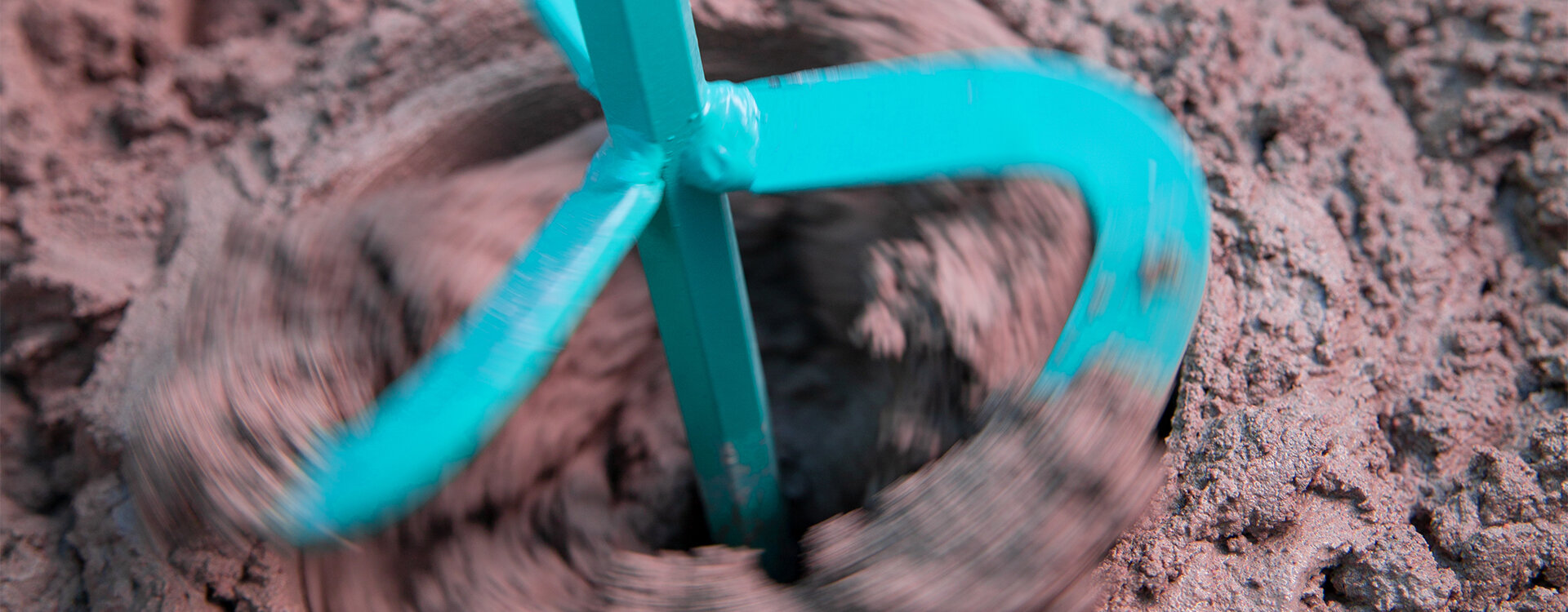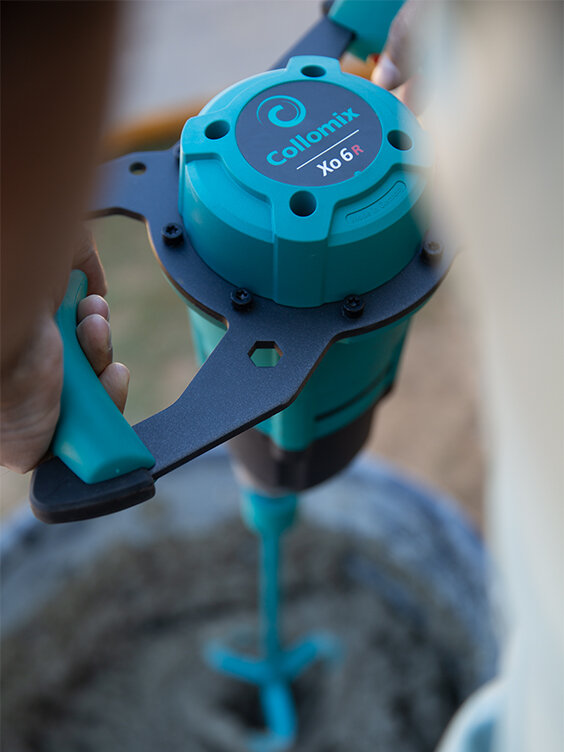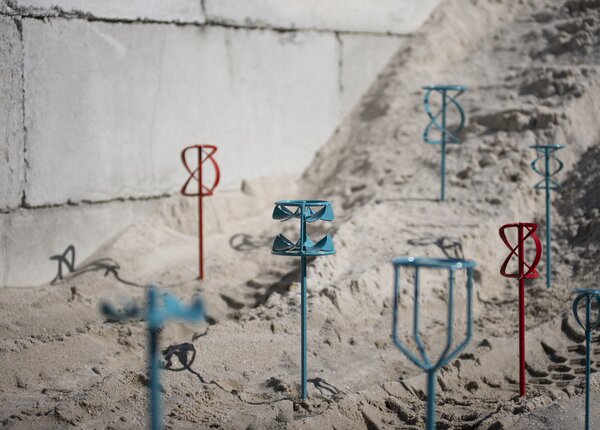
The Benefits of Mixing Properly
How to Color Concrete
Color adds flair and brilliance to standard concrete and gives personality to your building projects. Colored concrete can be a thing of beauty, provided that the color is expertly applied or evenly distributed throughout the concrete. So, how do you color concrete? There are many methods for applying color to concrete, including methods that color the surface and methods that distribute color throughout.
Mixing concrete with color is an art. Doing so takes knowledge of the process and most importantly, the right tools to get the job done. In this tutorial you'll learn about different methods to color concrete, which tools are necessary for mixing color into concrete, and how to mix integral dye into wet concrete. We chose this method of coloring concrete specifically because it's a cost-effective way to achieve lasting color on your concrete forms. With Collomix tools, coloring your concrete is fast, easy, and effective.

Different Methods to Color Concrete
There's more than one way to get the job done when you're coloring concrete. Some methods allow you to color concrete that's already been laid and dried, other methods are specifically aimed at coloring concrete that hasn't yet dried. Below are several methods for coloring concrete using a variety of materials. The method you choose for your project should depend on the state of your concrete, your budget, and how bright and brilliant you'd like your colored concrete to be – for example, using a concrete dye powder will result in a different color effect than tinted concrete etc.
Concrete Paint. Concrete paint is designed to bond with hardened concrete; filling the pores and providing full coverage of the concrete surface. The concrete itself is fully covered by the opaque layer of paint and does not show through once paint is applied. Concrete paint allows the user to achieve brilliant color and create detailed patterns but, the paint itself can chip or wear down over time. Concrete paint is appropriate for anyone seeking to paint a concrete floor or paint a mural. This is not a concrete coloring mix or the use of powder concrete color, but we felt it important to mention anyway as a means of adding color to concrete.
Concrete Dye. Concrete dye is a translucent coloring agent that's absorbed into concrete pores to create a subtle but attractive coloring. Dye is a non-reactive substance that creates a relatively stable, consistent color across the concrete surface. Dye is commonly used to color floors in commercial buildings, public buildings, and apartments. Dyes are often sold in powder form, known as “powdered colorant for concrete” or “concrete coloring powder”, and there are many concrete dye colors.
Concrete Stain. Concrete stain is acidic and bonds with cured concrete easily. It won't wear down or chip off like concrete paint, but it can be visually inconsistent. Achieving a solid, consistent color can be difficult or impossible.
Operators who choose to use concrete stain are usually seeking a special effect. For example, they may be trying to make their concrete look like tanned leather or marble, in which case, the unusual and inconsistent coloring of stain is helpful.
Tinted Sealer. Tinted sealers combine the protective qualities of concrete sealer with a soft tint that colors the concrete. Tinted sealer is often used outdoors on patios, pool decks, and other concrete formations. If you're planning to seal and color your concrete anyway, tinted sealer is a two-for-one product that achieves both goals at the same time. Tinted concrete sealer will wear off with time because it's not penetrative like stain.
Dry-Shake Color Hardener. A dry-shake color hardener or powdered colorant for concrete is a powder that's mixed into the surface of freshly laid concrete before the concrete dries. The concrete color powder is evenly distributed over the surface of the concrete, then it's worked into the concrete using a float or trowel. The color remains at the top where it is vibrant and concentrated. Dry-shake color hardeners come in a range of hues including shades of blue, green, brown, and red. Hardeners are made up of minerals that help make the concrete more dense and thus stronger overall.
Integral Dye. Integral dye is a dye that's mixed with wet concrete to create one consistent color. Because the dye is mixed into a whole batch of concrete, it's evenly distributed throughout the batch. After the dye is mixed with the colored concrete, the concrete is laid and allowed to cure. Integral dyes can be made of synthetic pigments or can be made from natural iron oxide.
Integral dye has several advantages over other concrete colorants. Because the color is consistent throughout the surface of the concrete, the concrete never needs to be recolored or touched up no matter how much the concrete wears down over time. In addition, integral dye saves the operator time since the concrete doesn't need to be colored after the concrete has been set and cured.
How to Add Color to Concrete
Coloring concrete with integral dye is relatively easy. See below, the steps to mixing integral dye.
Gather Your Materials. Start by gathering your tools and materials. Your project is no better than the materials you use, so it's important to take care to get the highest quality tools and materials possible. Here's what you'll need to get the job done to color concrete mix:
• Integral dye
• Paper bag
• Concrete mixture
• Collomix mixer, Collomix buckets and Collomix paddles (type WK and MK) OR Collomatic Compact Mixer
• Safety goggles
• Respirator rated for silica dust
• Waterproof safety gloves
Drill vs. Mixer - Which Should You Use? It's important to use a quality concrete mixer for this project. Some contractors and DIYers use drills to mix their concrete, to adverse effect. Drills are not made for mixing thick, viscous substances like concrete or mortar. Drills are made for drilling, a process that requires more speed and less power. For this reason, drill motors can easily overheat in a mixing situation. Using a drill could put your batch of concrete at risk, as mixing the color thoroughly throughout the batch may not be possible. Using your drill for this purpose also puts your drill at risk.
Safety Check. Concrete dye powder should not be inhaled, nor should wet concrete splatter on bare skin. Using the proper PPE is crucial for protecting your lungs, eyes and skin. Wear proper PPE throughout this project to protect your body from potential injury. Wear waterproof boots, long sleeves and trousers, and tuck your sleeves and trousers into your boots and gloves.

How to Color Concrete Mix
1. First, the concrete should be thoroughly mixed before integral dye can be added to it. Always start by adding the appropriate amount of water first before adding dry material, including concrete colorant powder. If using the Collomatic Compact Mixer, load it with the correct amount of water and concrete for your job and start the concrete mixing process. Be sure to follow all manufacturer instructions for your model. If using the Collomix handheld mixer and bucket, load the bucket with the correct amount of water and concrete. Install the paddles on the mixer machine and insert paddles into the bucket. Turn the paddles on.
2. The MK paddle is recommended for this project, because it will mix from the bottom up. This paddle is also rated for use with thick, viscous substances like concrete and mortar. The triple blades have a better mixing effect on concrete resulting in even distribution, better incorporation of the color, and a more thorough mix overall.
3. Add the integral dye to the now mixed concrete. Integral color or concrete colorant comes in powder form usually in pre-measured, dissolvable bags that can be added straight to the concrete mix. That’s right, toss the entire bag of concrete color powder in the mix. If the bag of dye is too much for the batch of concrete, remove the correct amount of concrete dye powder from the manufacturer's bag and place it in a separate container, then pour the correct color measurement in by hand. Follow all manufacturer instructions when mixing concrete and when mixing integral dye into concrete.
4. Mix the dye. Concrete dye colors need to be mixed with concrete for a specified period of time to ensure the dye is fully mixed throughout the concrete.
5. Lay down your concrete. Once the dye has been fully mixed with the concrete, lay your concrete out as you normally would.
Tips in How to Make Colored Concrete
It takes practice to color concrete effectively. If you're a non-professional wondering how to color concrete DIY, start by creating a sample of the concrete and mixing integral color before starting your project. Performing a trial run will help you understand how integral color works and will also help you decide how much concrete dye powder is necessary to achieve the color you're seeking.
If possible, mix the entire batch of concrete in one go to ensure consistent color. Mixing another batch of concrete colorant later, you may have a hard time matching the color to the first batch.
Some companies that make integral concrete dyes will make custom colors. If you're not finding the color you want for your project, seek help from a dye company that will make a custom integral dye for your needs.
Tools Matter
To get the best results when mixing integral color and tinted concrete in your concrete forms, use tools that you can count on. Seek a concrete mixer with an ergonomic design and quality construction to ensure that your concrete is properly mixed for your project. Ultimately, using the right products can save time and money by ensuring that your project will be finished on time and correctly. Don't waste time on drills that aren't designed to do the job – get the product that will get the work done right.
